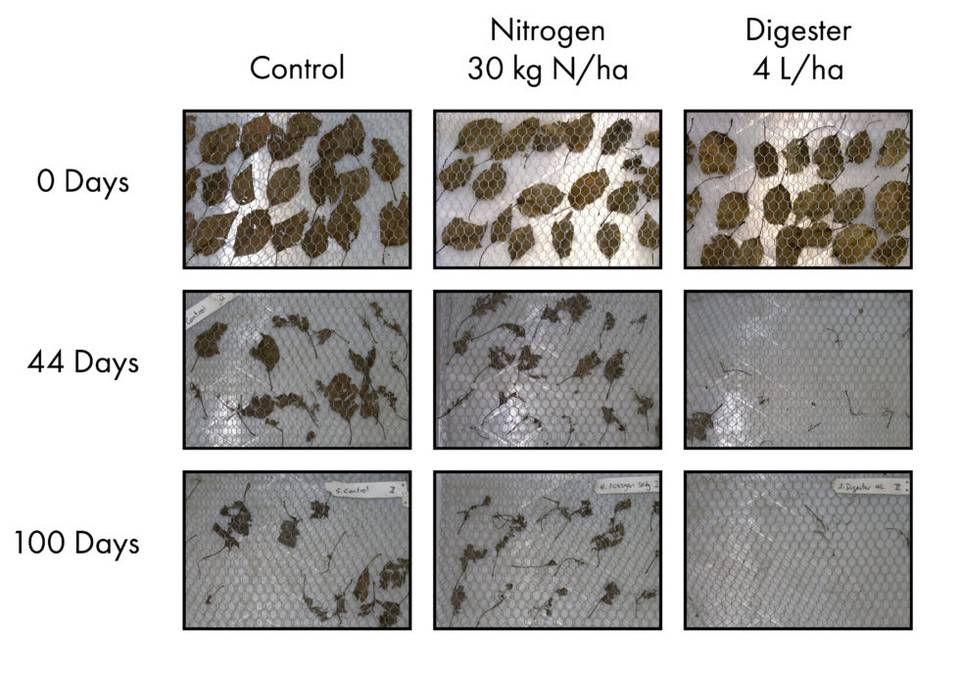
Soil microbial stimulator that activates beneficial naturally occurring saprophytic microbes in your soil that are responsible for plant material decomposition.
Key Benefits
- Speeds up crop residue decomposition
- Reduces opportunity for disease over-wintering
- Improves nutrient recycling and soil structure
Key Components
Digester consists of a combination of bacteriocins, enzymes, signal molecules and secondary metabolites from the fermentation of beneficial bacteria.
Mode of Action
Digester is made from fermentation extracts of the beneficial soil microbe Pseudomonas putida, which work by activating the saprophytic fungi in the soil involved in decomposition.
Digester is used to promote the rapid breakdown of leaf litter, cover crops, old roots and post-harvest crop trash in horticultural crops.
Applied directly to residual plant material, Digester activates decomposition microbes already present in the soil.
Digester reduces disease on the following crop by completely decomposing the plant material that plant pathogens use as a host over winter.
Digester comparison

Directions for Use
3-4 L per sprayed ha in a minimum of 200 L of water
Apply Digester directly on to leaf litter, prunings and other crop residues.
Requires soil moisture/rain and active soil biology.
Digester can be tank mixed with herbicides and fertilisers.
Digester can be applied through fertigation and overhead irrigation.
In low organic matter soils, low fertility soils, after long dry spells or high crop residue levels add technical grade ammonium sulphate at 30 kg/ha.
For best results avoid applying Digester in the heat of the day.
Treated crop residues may be lightly incorporated where possible to maintain moisture.
Use the higher rate in blocks with heavy overwintering disease pressure, compacted or waterlogged soil.
4-6 L per sprayed ha in a minimum 200 L of water
Apply Digester directly on to leaf litter, prunings and other crop residues.
Requires soil moisture/rain and active soil biology.
Digester can be tank mixed with herbicides and fertilisers.
Digester can be applied through fertigation and overhead irrigation.
In low organic matter soils, low fertility soils, after long dry spells or high crop residue levels add technical grade ammonium sulphate at 30 kg/ha.
For best results avoid applying Digester in the heat of the day.
Treated crop residues may be lightly incorporated where possible to maintain moisture.
Use the higher rate in blocks with heavy overwintering disease pressure, compacted or waterlogged soil.
2-4 L per sprayed ha in a minimum 200 L of water
Apply via fertigation or with the last weed spray before harvest.
Apply Digester directly on to leaf litter, prunings and other crop residues.
Requires soil moisture/rain and active soil biology.
Digester can be tank mixed with herbicides and fertilisers.
Digester can be applied through fertigation and overhead irrigation.
In low organic matter soils, low fertility soils, after long dry spells or high crop residue levels add technical grade ammonium sulphate at 30 kg/ha.
For best results avoid applying Digester in the heat of the day.
Treated crop residues may be lightly incorporated where possible to maintain moisture.
Use the lower rate in soils with low organic matter.
Compatibility
Digester is compatible with most commonly used herbicides, fertigation nutrients/nutrient sprays and suspension fertiliser.
Physico-chemical Properties
Density (at 20°C) 1.2 kg/L
pH 3.2-4.0
Downloads
